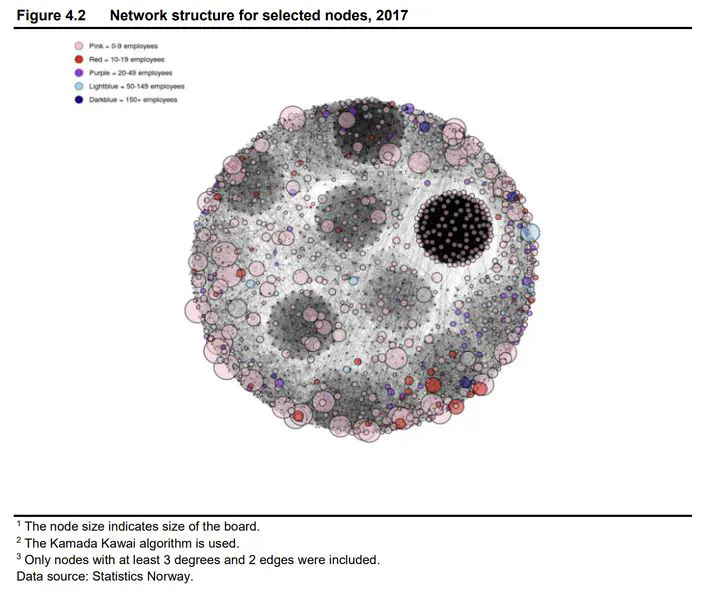Relational capital. Do board networks exist and are they valuable?
Oct 1, 2019·, ·
0 min read
·
0 min read
Erik Fjærli
Marina Rybalka
Solveig Bjørkholt

Abstract
This report attempts to seize the term relational capital, defined as an enterprise’s network participation. We use network analysis tools on Norwegian register data and demonstrate that there indeed exists a network between enterprises, through boards forming interconnected nodes. The network also contains many sub-networks (clusters).
Opposed to most of the previous studies our data contain information on small and medium-sized enterprises (SMEs). We find that the SMEs are highly network forming and that this sub-group of enterprises forms a network with a very lumpy structure, i.e., having the tendency to form clusters.
We also examine how the network evolves from our starting point in 2004 to 2017 and find that the network expands as the enterprise population increases. Both the number of boards and board members has increased where the former has increased faster, implying more boards per board member over time.
Board networks can be analysed at the individual level, where the nodes in the network consist of board members, or at the enterprise level where the nodes consist of enterprises. At the individual level, we find that gender affects the density of networks, women having higher network density. However, this could possibly be an effect of women’s network being smaller than men’s network.
Looking at nodes defined by enterprises, we present in chapter 5 an analysis of how R&D spending is related to an enterprise’s connectedness to the network. On the proviso that we do not know much about the mechanisms or the nature of causal relationships, we find that a high network connectedness has a positive impact on R&D spending. Most interesting, we find that this correspondence is particularly strong among SMEs. Our findings suggest that network participation may add value to enterprises through transmission of information or other incentives to increased R&D effort, and that board networks may represent such a channel.
Opposed to most of the previous studies our data contain information on small and medium-sized enterprises (SMEs). We find that the SMEs are highly network forming and that this sub-group of enterprises forms a network with a very lumpy structure, i.e., having the tendency to form clusters.
We also examine how the network evolves from our starting point in 2004 to 2017 and find that the network expands as the enterprise population increases. Both the number of boards and board members has increased where the former has increased faster, implying more boards per board member over time.
Board networks can be analysed at the individual level, where the nodes in the network consist of board members, or at the enterprise level where the nodes consist of enterprises. At the individual level, we find that gender affects the density of networks, women having higher network density. However, this could possibly be an effect of women’s network being smaller than men’s network.
Looking at nodes defined by enterprises, we present in chapter 5 an analysis of how R&D spending is related to an enterprise’s connectedness to the network. On the proviso that we do not know much about the mechanisms or the nature of causal relationships, we find that a high network connectedness has a positive impact on R&D spending. Most interesting, we find that this correspondence is particularly strong among SMEs. Our findings suggest that network participation may add value to enterprises through transmission of information or other incentives to increased R&D effort, and that board networks may represent such a channel.
Type
Publication
Statistics Norway Report 2019/36